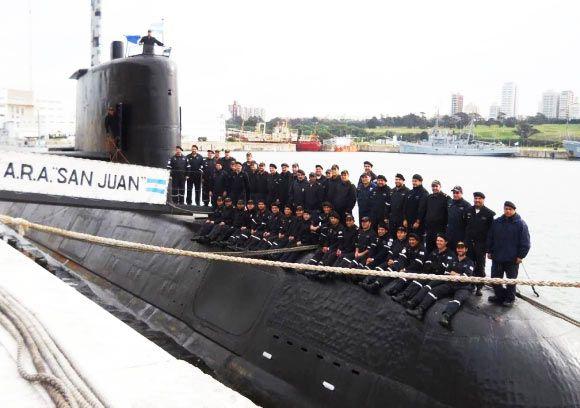The 15 November 2017 the ARA submarine San Juan of the Argentinean Navy loses contacts with the naval base of Ushuaia, in Mar del Plata. From that moment began a frantic search for the boat, hampered by prohibitive weather conditions in the south Atlantic. It is a series of false traces, contradictory statements and misplaced hopes, until the harsh reality emerges in November 28, when the Argentinean Navy reveals the cause of the disappearance of the boat.
The last message sent by San Juan November 15 warned: "Water came from the snorkel in the electric battery room and this caused a short circuit and a fire principle. We proceed in immersion with half power. We will keep you posted"But it is the Organization of the Comprehensive Test Ban Treaty (Ctbto), integrated into the UN system, to report that it detected an unusual signal near the last known position of the missing submarine." Two Cto hydro-acoustic stations , this UN body reports in a short statement, have found "an underwater impulsive event occurred at the 13.51 GMT of the November 15"at a latitude of -46,12 degrees and longitude of -59,69 degrees.
The last location of the submarine is the San Jorge Gulf area, 268,5 miles from the Argentine coast, 30 miles from the last known position. In its brief statement of just three paragraphs, the Ctbto puts its data at the disposal of the Argentine authorities to support the ongoing research operations (1). Certainly after that message of the November 15 will know nothing more of the boat and the 44 military crew, including the first woman in the history of the Argentine Navy, Eliana Maria Krawczyk.
This is the chronicle.
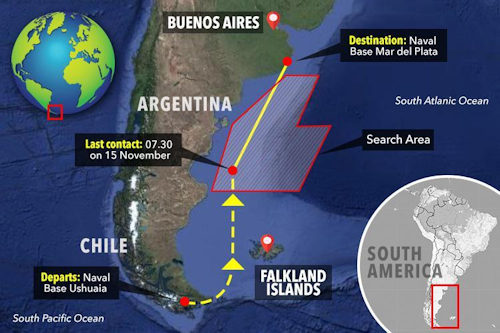 In this article we will now try to understand what may have happened, using different specialized sources. Meanwhile, the boat: class TR-1700, launched in Germany in the 1983 and entered service in the 1985 for the Argentine Navy (ARA) with the initials S-42, the San Juan it was a classic diesel / electric mixed propulsion boat, 66 meters long, 2116 tons of displacement, 2264 in immersion (2). Diesel engines are normally used in emergence, while the electric motor, not consuming air, ensures the propulsion in immersion. The accumulators are recharged by diesel engines, similar to the current hybrid powered machines. In the 2011, at mid working life, the San Juan it had been subjected to a complete overhaul, which included, among other things, the complete replacement of the accumulators. But on this we will come back.
In this article we will now try to understand what may have happened, using different specialized sources. Meanwhile, the boat: class TR-1700, launched in Germany in the 1983 and entered service in the 1985 for the Argentine Navy (ARA) with the initials S-42, the San Juan it was a classic diesel / electric mixed propulsion boat, 66 meters long, 2116 tons of displacement, 2264 in immersion (2). Diesel engines are normally used in emergence, while the electric motor, not consuming air, ensures the propulsion in immersion. The accumulators are recharged by diesel engines, similar to the current hybrid powered machines. In the 2011, at mid working life, the San Juan it had been subjected to a complete overhaul, which included, among other things, the complete replacement of the accumulators. But on this we will come back.
Meanwhile, that day the San Juan certainly sailed in immersion, the sea conditions on the surface being prohibitive: wind over 45 knots and waves of up to 9 meters. In reality, the oceanic wave motion depends a lot on the wavelength and little on the height, so the effect is felt up to half the wavelength, i.e. from 5 to 50 meters, the wave motion decreasing in a exponential with depth. Therefore, there was no reason to surf the surface and be subjected to any kind of stress. In fact, radio contact is only possible if the unit navigates on the surface or in any case with the antenna used for communications, beyond the surface of the water.
But let's go back to the last message: "the water entered the snorkel in the electric battery room and this caused a short circuit and a fire principle. We proceed in immersion with half power".
The snorkel is the system that, using a long air intake pipe from the outside, ensures, when the submarine is under the water surface and the pipe is lifted and the valves are opened, the internal air exchange , but above all the air inlet for the operation of diesel engines, which air can not do without. When the snorkel is not used, that is during the dive navigation, the snorkel tube is flooded up to the resistant hull.
 According to the technicians, water can also enter the snorkel, but never with devastating effects. In fact, the snorkel has at least three valves: one at the top of the barrel (head valve) to prevent the entry of waves, and two near the resistant hull to withstand the maximum altitude, being the snorkel bar flooded when the submarine is submerged. After the barrel there is usually a collection system to prevent any incoming water from starting to flow along the pipelines, a system that should have high-level safety devices that close the resistant valves. Once the snorkel is lifted, between the checks provided before the effective air inlet, the head valve is tested, which has two electrical contacts (24 volt, AC), which in the water are shorted and automatically close the valve. Care of the guard officer is therefore to check the contacts and the sealing of the gaskets before activating the snorkel. And if the boat drops below the level of snorkel, obviously the head valve closes and on board they immediately notice it: the diesel running will suck the air from inside the boat, creating a sudden depression, which if it lasts for a long time , leads to the engine shutdown. Little water can also enter if the sea is in a storm, but is collected in a special well that is then drained with drainage pumps or for simple decanting in appropriate boxes on board. But if the head valve has a mechanical or electromechanical fault, then it enters so much water and quickly, as it did to the USS Squalus in the 1939 (3).
According to the technicians, water can also enter the snorkel, but never with devastating effects. In fact, the snorkel has at least three valves: one at the top of the barrel (head valve) to prevent the entry of waves, and two near the resistant hull to withstand the maximum altitude, being the snorkel bar flooded when the submarine is submerged. After the barrel there is usually a collection system to prevent any incoming water from starting to flow along the pipelines, a system that should have high-level safety devices that close the resistant valves. Once the snorkel is lifted, between the checks provided before the effective air inlet, the head valve is tested, which has two electrical contacts (24 volt, AC), which in the water are shorted and automatically close the valve. Care of the guard officer is therefore to check the contacts and the sealing of the gaskets before activating the snorkel. And if the boat drops below the level of snorkel, obviously the head valve closes and on board they immediately notice it: the diesel running will suck the air from inside the boat, creating a sudden depression, which if it lasts for a long time , leads to the engine shutdown. Little water can also enter if the sea is in a storm, but is collected in a special well that is then drained with drainage pumps or for simple decanting in appropriate boxes on board. But if the head valve has a mechanical or electromechanical fault, then it enters so much water and quickly, as it did to the USS Squalus in the 1939 (3).
In the case of San Juan the crew's reaction may not have been quick, and water may have entered the battery compartment. The radio message was clear: the water passed through the snorkel and entered the sub-battery no. 3. The Germans numbered from stern to bow, so it is the forward power plant, the one closest to the snorkel, causing a fire. It is unclear whether the fire developed in the room or on the safety switches of sub-battery # 3. More importantly, it's not clear whether the batteries lost power before they even shorted in salt water. Why ever go up to snorkel with that sea if not to recharge the accumulators with diesel engines?
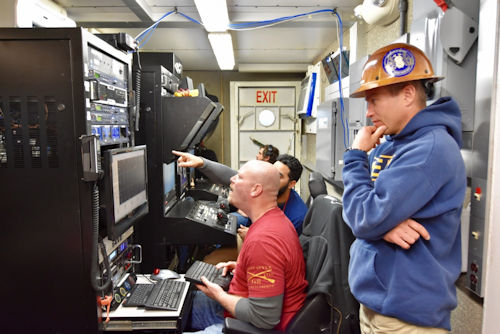 A spokesman for the Argentine Navy (Enrique Balbi) reports that the cause of the failure was the entry of water through the snorkel, which caused the short circuit of one of the batteries. They would have isolated it and, despite the problem, they would continue the dive trip to Mar del Plata, using the 1 and 2 sub-batteries and trying to fix the fault, rather than being tossed around by surfacing. So they believed they had stemmed the problem, then something went wrong. But it must also be said that the battery compartment is for obvious reasons well insulated and the possibility that it enters water is relative. So I would suggest the hypothesis of a progressive loss of power or a serious failure to the batteries before the maneuver of ascent and the entrance of the water from the snorkel, which sent everything in short producing toxic gases (chlorine, hydrogen). Burning without flame, but toxic. This could have paralyzed the reaction of the crew: even a failure to the propulsion board (which dispenses the electricity of the batteries and generators) had to allow emergency emergence (with a hydrazine system) (4). Not only that: each boat is equipped with more than one security device capable of communicating in the event of a failing position or in any case launching an SOS: submarine radio telephones, low frequency radio communications, and it is likely that these equipment were in efficiency, otherwise the San Juan they would not have set sail for such a long journey. It seems however that there was not the EPIRB buoy (it automatically disconnects and launches a satellite distress signal). As for the air transmissions, they may not have had the necessary scope to reach the 400 Km from the coast and beyond the Navy bases.
A spokesman for the Argentine Navy (Enrique Balbi) reports that the cause of the failure was the entry of water through the snorkel, which caused the short circuit of one of the batteries. They would have isolated it and, despite the problem, they would continue the dive trip to Mar del Plata, using the 1 and 2 sub-batteries and trying to fix the fault, rather than being tossed around by surfacing. So they believed they had stemmed the problem, then something went wrong. But it must also be said that the battery compartment is for obvious reasons well insulated and the possibility that it enters water is relative. So I would suggest the hypothesis of a progressive loss of power or a serious failure to the batteries before the maneuver of ascent and the entrance of the water from the snorkel, which sent everything in short producing toxic gases (chlorine, hydrogen). Burning without flame, but toxic. This could have paralyzed the reaction of the crew: even a failure to the propulsion board (which dispenses the electricity of the batteries and generators) had to allow emergency emergence (with a hydrazine system) (4). Not only that: each boat is equipped with more than one security device capable of communicating in the event of a failing position or in any case launching an SOS: submarine radio telephones, low frequency radio communications, and it is likely that these equipment were in efficiency, otherwise the San Juan they would not have set sail for such a long journey. It seems however that there was not the EPIRB buoy (it automatically disconnects and launches a satellite distress signal). As for the air transmissions, they may not have had the necessary scope to reach the 400 Km from the coast and beyond the Navy bases.
Another apparatus that was to be present is an emergency underwater transmitter, which is activated manually or automatically and runs on battery even for 10 days. But here the physics of sound in the water intervenes and the range could not reach 100 Km. With adverse weather conditions such as those in the area, the background noise could cover the emission of the underwater transmitter. But the real problem is that the boat, now without electricity and / or weighed down by the water entered, and an indoor air degraded by gas, smoke and flames, at that point went to the bottom with all the crew.
The emergency lifts (RESUS, Rescue Systems for Submarines) are designed to operate in extreme emergency conditions, even in the absence of power and / or manual activation. The automatic activation is foreseen according to the quota (like on our U212A) or manual as redundancy to the electric failure (like on our Sauro). What happened on board the ARA San Juan it was therefore anomalous and sudden.
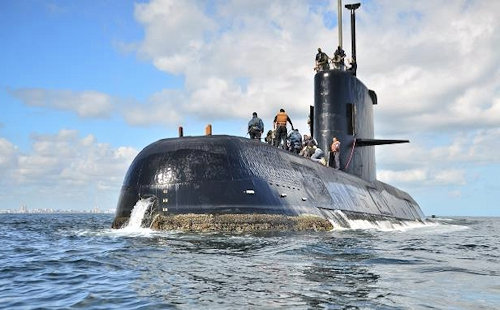
There is never a single cause, but the sum leads to tragedy. Our submariners are trained in a repetitive and manic way to emergency interventions, so as to develop precise behavioral automatisms. Rapid emergence here would have been possible - even without manual intervention for the rapid depletion of ballast tanks - if no other damage had occurred. The propulsion was almost certainly lacking, a great help to return to the surface, perhaps due to the fire damage or perhaps the flooding of the other sub-batteries. Perhaps the explosion in the battery has damaged some pipes of the general refrigeration, a circuit at the same pressure of the outside that could be not easy to intercept, creating a further strong flooding after the fire.
The route was at the limit of the continental shelf, but the implosion took place at a depth much lower than the theoretical collapse, causing the instant death of all the crew survived until then. According to Dr. Bruce Rule, an acoustic analysis expert who for 42 years was chief analyst at the Office of Naval Intelligence (ONI), that is the information services of the American Navy, the implosion took place at a depth of 388 mt. This is what the Rule writes:
1) The event in question, which occurred at 1358Z (GMT) of 15 November 2017 in the point with geographic coordinates 46 ° 10 'S-59 ° 42'W, was produced by the explosion of the submarine's resistant hull San Juan at a depth of about 1275 feet (about 388 meters), at which the sea pressure is equal to about 570 psi (pounds per square foot), ie 39,3 bar;
2) the implosion generated a kinetic energy equivalent to that produced by the detonation of about 12.500 pounds (about 5.700 kg) of TNT;
3) the frequency of the event was 4,4 hertz;
4) the velocity of the water column penetrated into the submarine's hull after the implosion was equal to about 1800 land miles per hour, ie about 2.900 km / h;
5) the hull of the San Juan it has collapsed in about 40 milliseconds, (1 / 25 of a second), equal to about half of the minimum time required by human senses for the cognitive recognition of an event;
5) the remains of the San Juan they are sunk vertically at an estimated speed between 10 and 13 nodes;
6) the impact of these remains on the ocean floor did not produce further detectable acoustic events at long range;
7) if the wreck is found and it is decided to recover parts, it is suggested to concentrate the analysis on the submarine's battery system.
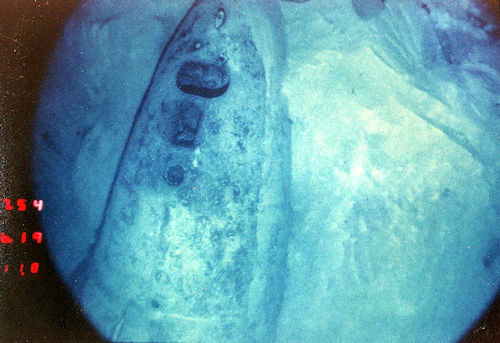 Incidentally, Bruce Rule is also the coordinator of: "Why the USS Scorpion (SSN 589) was lost: the death of a submarine in the North Atlantic"(Rest 2011), related to the loss of the American nuclear submarine Scorpion (photo), dispersed off the Azores in May 1968 with 99 men on board. And here too there were batteries (5).
Incidentally, Bruce Rule is also the coordinator of: "Why the USS Scorpion (SSN 589) was lost: the death of a submarine in the North Atlantic"(Rest 2011), related to the loss of the American nuclear submarine Scorpion (photo), dispersed off the Azores in May 1968 with 99 men on board. And here too there were batteries (5).
But let's move on to the batteries and their presumed flameless combustion. An investigation by the Argentine Defense Ministry has shown that the Navy has committed violations of the rules for the purchase of batteries for the disappearance of the submarine San Juan, reports the edition of Nacion, referring to the internal documents of the ministry. As the newspaper notes, the investigation conducted by the ministry in the 2015 and 2016 revealed that the Navy representatives may not have followed the regulations for the repair of the submarine and the replacement of batteries, and that the purchase of batteries may have been managed in the interest of some suppliers.
"The information gathered makes it possible to state that the contract not only did not correspond to the administrative procedure, but also that contract managers probably committed illegal actions, in the interests of the companies Hawker Gmbh and Ferrostaal AG", says the newspaper quoting the documents of the ministry.The results of this investigation coincide with the data of the general management of the controller of Argentina, which confirms the presence of irregularities.The control technicians also found that, due to the delay of In the purchase process, expired batteries were bought in. In essence, two German manufacturers would have grabbed their batteries opaque, according to information from the German portals BR Recherche and ARD-Studio Südamerika, two German companies would have bought up the replacement devices paying bribes and installing poor quality products to save money.From a complete review of the "San Juan" concluded in 2011, Ferrostaal and EnerSys-Hawker had obtained a contract for the delivery of 964 cells for an amount of 5,1 millions of euros According to what is indicated in the newspapers by some Argentine politicians, it is practical sure that the two German companies have paid bribes to get that order. A charge filed in the 2010 in this sense ended up in a cover-up.

Regarding the quality of the goods delivered, Schmidt-Liermann commented: "There is a suspicion that the batteries were not, in part or not at all, the quality that should have been ... we do not even know where they came from, whether from Germany or another country".
At this point, it is appropriate to focus on the long and complex modernization work that the San Juan had suffered between the 2008 and the 2014. These works were carried out by the Argentine shipbuilders Cinar (Complejo Industrial y Naval Argentino) of Buenos Aires, a state company resulting from the merger of the two Domecq Garcia and Tandanor shipyards. The Domecq Garcia are the construction sites that had begun, under German supervision, the construction of the four twins of the San Juan and Santa Cruz (which were both made in Germany), ie the Santa Fe and Santiago del Estero, never completed (the hulls are still on the airports for more than twenty years waiting for decisions) like two other units that were not even started. The four units would have been, absolutely, the first ever made in Argentina. In other words, no submarine built in Argentina has ever really sailed. After the privatization and subsequent dissolution of the shipyards, now bankrupt due to the severe economic crisis that the South American country has undergone in the years 90, the Kirchner government decided to reorganize the national shipbuilding trying to recover the skills and part of the skilled workers necessary to realization and maintenance of complex units such as underwater ones. Meanwhile, for the refitting of the Santa Cruz, the twin of the San Juan which needed major upgrading and maintenance, the Argentinean Navy was forced to resort to the help of Brazil (a country that, in South America, is more advanced in skills). The Santa Cruz was then subjected, between 1999 and 2001, to major modernization works at the Arsenal de Marinha in Rio de Janeiro. Reorganized the national yards, similar works were also planned for the San Juan, but were made directly in Argentina from the 2008 to the 2014. It should be emphasized, as evidence of the difficulties encountered in the national shipyards, which on the Santa Cruz the Brazilians employed about three years for the works, while for similar interventions on the San Juan he served, in Argentina, a period almost double. The four diesel engines, the electric propulsion engine and the 960 battery elements, totaling about 550 tons, were completely disembarked and overhauled. In addition to the boarding of new acoustic sensors and an updated combat system, around 9 km of various types of piping and over 25 km of electric cables were replaced, while the almost 1300 valves needed for the various on-board services were dismantled and overhauled.
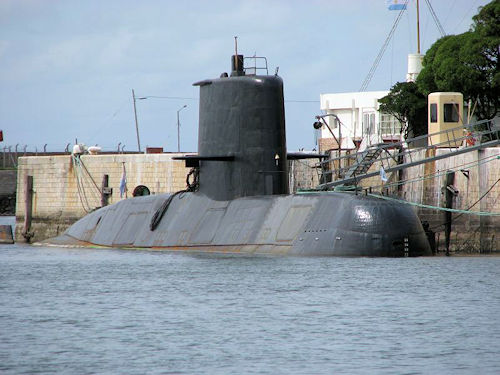 The 1700 class TR submarine hull is made of HY 80 steel, a special low carbon steel (also used for Italian class submarines Sauro) which has a valuable feature for a submarine: it is rather elastic, but very resistant, with a high yield limit (High Yeld, ie HY) equal to 80.000 pounds per square inch (36.287,3896 kg / 6,4516 cmq.). However, this material requires special welding techniques. To allow the disembarkation of the large elements that could not pass from the two existing boarding doors on board, during the works it was necessary to literally cut the hull of the San Juan which was then soldered again. As you can easily imagine, being underwater units that withstand significant stresses due to sea pressure at high altitude, and in the presence of the already mentioned HY 80 steel, this is an extremely delicate operation that requires special attention, equipment and adequate procedures and highly qualified and specially certified workers, who must be constantly trained to maintain their skills unaltered. All over the world there are not many sites able to carry out these activities in complete safety and the fact that the work on the site San Juan have been entrusted to construction sites affected by troubled business events, which for years have not operated in the sector and in a country afflicted moreover by a long and devastating economic crisis is to be considered a risk area should not be underestimated. They certainly can not be underestimated by the investigators who will have to investigate the causes of the disaster.
The 1700 class TR submarine hull is made of HY 80 steel, a special low carbon steel (also used for Italian class submarines Sauro) which has a valuable feature for a submarine: it is rather elastic, but very resistant, with a high yield limit (High Yeld, ie HY) equal to 80.000 pounds per square inch (36.287,3896 kg / 6,4516 cmq.). However, this material requires special welding techniques. To allow the disembarkation of the large elements that could not pass from the two existing boarding doors on board, during the works it was necessary to literally cut the hull of the San Juan which was then soldered again. As you can easily imagine, being underwater units that withstand significant stresses due to sea pressure at high altitude, and in the presence of the already mentioned HY 80 steel, this is an extremely delicate operation that requires special attention, equipment and adequate procedures and highly qualified and specially certified workers, who must be constantly trained to maintain their skills unaltered. All over the world there are not many sites able to carry out these activities in complete safety and the fact that the work on the site San Juan have been entrusted to construction sites affected by troubled business events, which for years have not operated in the sector and in a country afflicted moreover by a long and devastating economic crisis is to be considered a risk area should not be underestimated. They certainly can not be underestimated by the investigators who will have to investigate the causes of the disaster.
Another area of risk well known by those who deal with submarines is constituted by the so-called "camolature" (or "pits"), ie the punctiform corrosion phenomena, also called "pitting" with Anglo-Saxon terminology, which can reduce the thickness of the steel and therefore weaken its resistance. "Pitting" is a very insidious phenomenon and is particularly favored by sea water, which is the ideal environment for its development due to the high concentration of sodium chloride ions and other salts. During the stops on the site of a submarine, the technicians pay special attention to the search for "pitting" and, where necessary, intervene affixing on the hull the "wipers" of sheet metal welded that serve to replenish the original thickness and restore the characteristics of resistance of project. Obviously the unidentified and not suitably opposed pitting phenomena constitute a potentially deadly hazard for a hull designed to withstand very high pressures.
The 1700 class TR submarine hull was designed to operate at a height of 270 meters (300 meters, according to other sources) with a safety factor presumably equal to 2. The safety factor is the number useful to determine the collapse depth, ie the maximum tolerable one before a hull yields. A submarine designed for an operating altitude of 270 meters with 2 safety coefficient will resist up to 540 meters depth (270x2), one with 300 meters of operating altitude will resist up to 600 meters (300x2) and so on. Even assuming for the San Juan a more prudential safety coefficient of design, equal to 1,5 only, would have, respectively, a collapse depth of 405 or 450 meters, in any case higher than 388 meters to which the hull has yielded. If the San Juan it collapsed to a more modest depth than it would have had to endure, it is because it had been most likely downgraded as to operational depth, given its 25 years of service.
NOTES
(1) https://www.ctbto.org/press-centre/media-advisories/2017/media-advisory-... . For the analysis of the acoustic anomaly done by a technician, see: https://youtu.be/bc39NVy1v20
(2) https://it.wikipedia.org/wiki/ARA_San_Juan_(S-42)
(3) Testimony of Charles Green, USN Submarine Service (Ret.)
(4) Hydrazine containers in contact with the sea develop gas. The contact is made electrically with dedicated batteries and the drive buttons are in each room of the boat. For RESUS systems (Rescue Systems for Submarines), see: http://www.space-propulsion.com/resus/index.html
(5) I quote: In their official report of the 29 January 1970, the SCORPION Structural Analysis Group (SAG), which includes the Navy's leading experts in submarine design, submarine structures, and the effect of underwater explosions, advised the Navy Court of Inquiry (COI) that the US nuclear submarine SCORPION was lost on the 22 May 1968 because of the violent explosion of the main storage battery. The COI disregarded that assessment and concluded SCORPION was lost due to the "explosion of" (a) large external weight charge to the submarine's pressure hull. " That erroneous conclusion which, by default, has become the Navy's contribution to the tragedy, contributed to the conspiracy theory that SCORPION was sunk by a Soviet torpedo. This book includes six letters sent to the Navy from 2009 to 2011. These letters provide the results of the first reanalysis in the 40 years of acoustic detections of the loss of SCORPION. This reanalysis confirms the 1970 SAG battery-explosion assessment and provides important information on the loss of SCORPION. The author was the lead analyst at the Office of Naval Intelligence (ONI) for 42 years, ending in 2007. ONI did not receive any SCORPION acoustic date until the author provided it in October 2009. Members of the Scorpion family members of the Scorpion families
(photo: web / MoD Argentina / US Navy)

